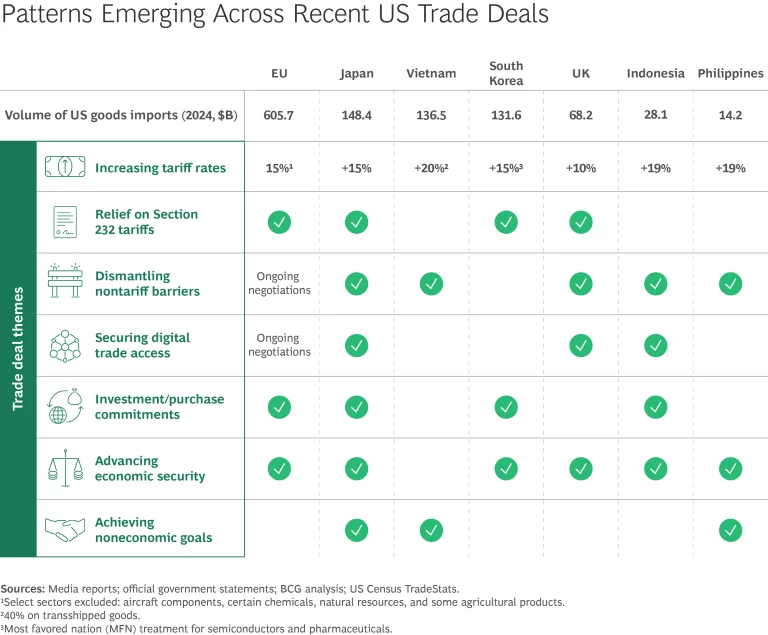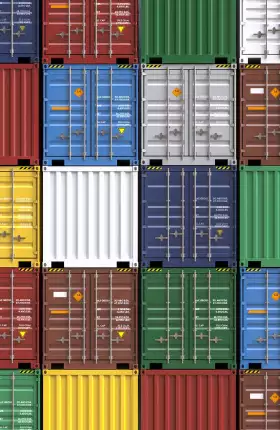Last week brought a series of tariff agreements and actions by the US government that did much to solidify a new trade landscape. However, if we have learned one thing in the last few months, it is that everything is subject to change. We have also learned that headlines don’t always tell the full story. So, it’s important to cut through the noise and focus on the underlying specifics and implications.
A Reshaped Landscape
The new patchwork landscape is much more complex and unclear than the most-favored-nation (MFN) system. Rates are more varied. Countries, products, and economic sectors are treated differently. The underlying levy logic can involve noneconomic factors and is not always transparent. The lack of clarity over trade deal terms leads to different interpretations and to disagreements.
Uncertainty will continue to be a factor, but global companies now have directional information about likely economic impacts, which will help them make longer-term decisions regarding likely scenarios, pricing, supply footprint, risk, and compliance.
Emerging Themes
Multiple themes are coming into focus.
High Rates. US tariffs have reached historically high levels. The new country rates cover some 60% of imported products. A total of 66 trading partners will pay tariffs of 15% or more. Importers of goods from countries with trade deficits in goods with the US will continue to pay 10% additional import taxes on top of MFN tariffs levied before April 2, 2025. Once implemented, overall trade-weighted tariffs will reach 17% (about 7 times higher than the 2.5% in December 2024). While the various tariff deals lay out likely floors for country-specific rates, there are no known upper limits, and some tariffs now reach 50%.
Not Going Away. While rates may continue to fluctuate, it is unlikely that the current tariffs will be fully reversed, given their political significance and role as a US revenue source. The combination of customs duties and some excise taxes generated $152 billion for the US Treasury through July 2025, almost twice the $78 billion in same time period a year ago. (US government revenues were $4.9 trillion in 2024.) And history shows that tariffs can be sticky: levies set during President Trump’s first term were mostly held steady, with slight increases, during the Biden Administration.
Agreement Supersedes Retaliation. All countries making agreements so far have suspended retaliation plans, thereby removing the immediate risk of widening trade wars. The EU, for instance, suspended its planned three-step retaliation process, but it could be reactivated in the event that agreed-upon terms are no longer honored.
A Complex Mix. Bilateral tariff treatment is the new US normal. Agreements appear to have been secured so far by six US trading partners (the EU, Indonesia, Japan, the Philippines, South Korea, the UK, and Vietnam) with headline rates varying from 10% to 19%. Several major US partners, including three of the largest (China, Canada, and Mexico), are involved in ongoing negotiations. For the latter two, it’s important to watch how the US-Canada-Mexico Agreement (USMCA) is revamped. Most other countries that have trade deficits with the US are subject to 10% tariffs. Countries with trade surpluses and no agreements face a wide range of rates:
- Some, such as Turkey, Norway, Iceland, and Liechtenstein, are looking at 15%.
- Others, including Serbia, South Africa, and Switzerland, are subject to levies of 30% to 40%.
- Tariffs on goods from Brazil will be 50% (the 10% floor rate plus an additional country-specific 40%).
Unless specifically exempted (as in the case of the EU-US agreement), most of these duties stack on top of existing MFN rates.
Sector and Product Levies. Overlaying the country patchwork are sector- and product-specific tariffs, including national security tariffs on steel, aluminum, autos, and copper. Further potential tariffs on pharmaceuticals and semiconductors under Section 232 of the 1962 Trade Expansion Act are currently under investigation. Product-specific rates also will vary by country according to bilateral agreements. For example, automotive tariffs are 15% for the EU, 12.5% for Japan, 10% on the first 100,000 vehicles exported annually from the UK (in line with previous quantities), and 27.5% for the rest of the world.
More Than Rates. Both the announced deals and the negotiations still underway include nontariff factors such as investment and purchase agreements and noneconomic goals. (See the exhibit.) The agreements with Japan and the EU include purchase and investment provisions. The US pinpoints fentanyl as an issue with China, Mexico, and Canada.

Featured Insights: Explore the ideas shaping the future of business
One-Way Streets. The agreements reached so far are predominantly one-way affairs with tariffs rising on imports to the US but no increases, and some decreases, on US exports to other countries. Digital services, in which the US leads, are unaffected so far. The suspension of duty-free de minimis treatment (no tariffs on goods worth less than $800) for all countries is raising concern among online retailers.
No Transshipment Allowed. Most of the trade agreements and tariff notices include strict rules-of-origin provisions. Vietnam, for instance, will face a 40% tax on goods originating from another country that stop in Vietnam on their way to the US.
Lost in Translation. Varying and conflicting details from partners on the agreements reached so far are raising questions regarding the deals’ scope and terms. For example, Washington has said that Japan will invest $500 billion in the US, which will take 90% of the profit. Japan has described the investments as a combination of investments, loans, and loan guarantees. It’s unclear whether the EU will secure exemptions for key sectors, such as aerospace, semiconductor equipment, pharmaceuticals, and some chemicals and agricultural products. Similarly, while the US-UK deal specifies the scope, reach, and specifics of a quota system for steel and aluminum, a similar exemption is not yet defined for the EU.
Details Matter. Specifics rarely make headlines, but for companies trying to navigate the new trade landscape, they matter. Much has been made of a 35% tariff on Canada, for example, but in reality some 90% of Canada’s imports to the US are covered by the USMCA and are therefore exempt.
Secondary Impacts of US Policy
US tariff measures have led other countries to seek stronger bilateral trade deals with other partners or take their own protectionist measures. For example, the UK and India have agreed on a deal that will eliminate duties on almost all of India’s exports to the UK. In return, India will move toward zero duties on 90% of UK goods within ten years.
Clarity, Complexity, and Uncertainty for Businesses
Despite continuing uncertainty regarding some rates and details, companies now have clarity about two things: tariffs will be higher, and complying with the new patchwork will be harder. The good news for tariff command centers is that they will not have to engage in nearly as much guesswork.
Still, companies must closely track developments because there will almost surely be more changes. They must also monitor compliance and remain vigilant to avoid potential penalties. Ensuring compliance may cause adjustments to supply chains, affecting overall operational effectiveness, and require enhancements to data, tools, and capabilities. It will remain crucial to factor geopolitical risk scenarios into business strategy. Most global businesses will need to use AI tools to enhance the capabilities of their tariff command centers to handle the new complexities.
On the plus side, individual companies may, down the road, be able to achieve specific exemptions and provisions. Assessing relative exposure to competitors will be key given that some companies will benefit more than others from their manufacturing and supply chain footprints.
The new patchwork may be clearer than it was, but it also puts new burdens on global management.




